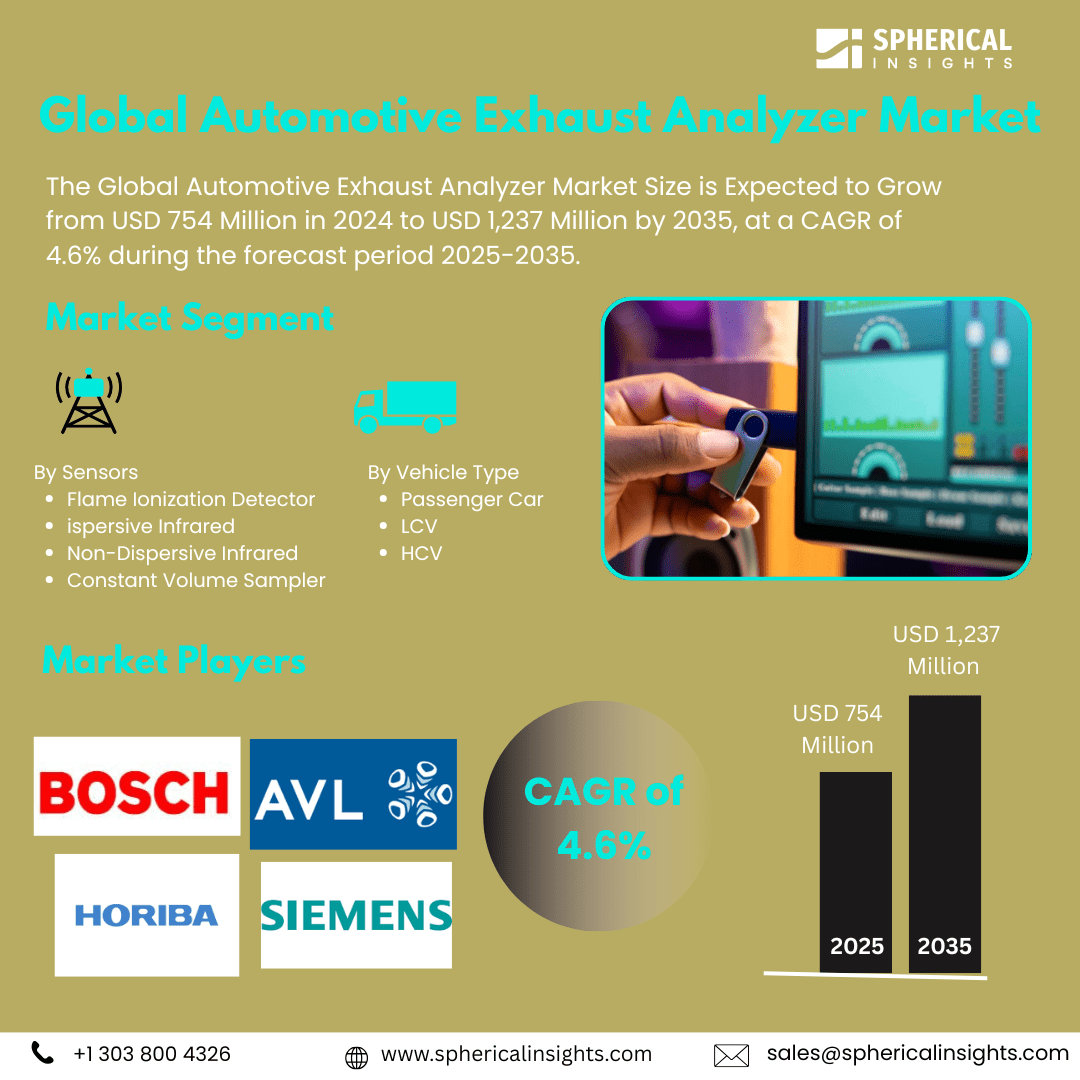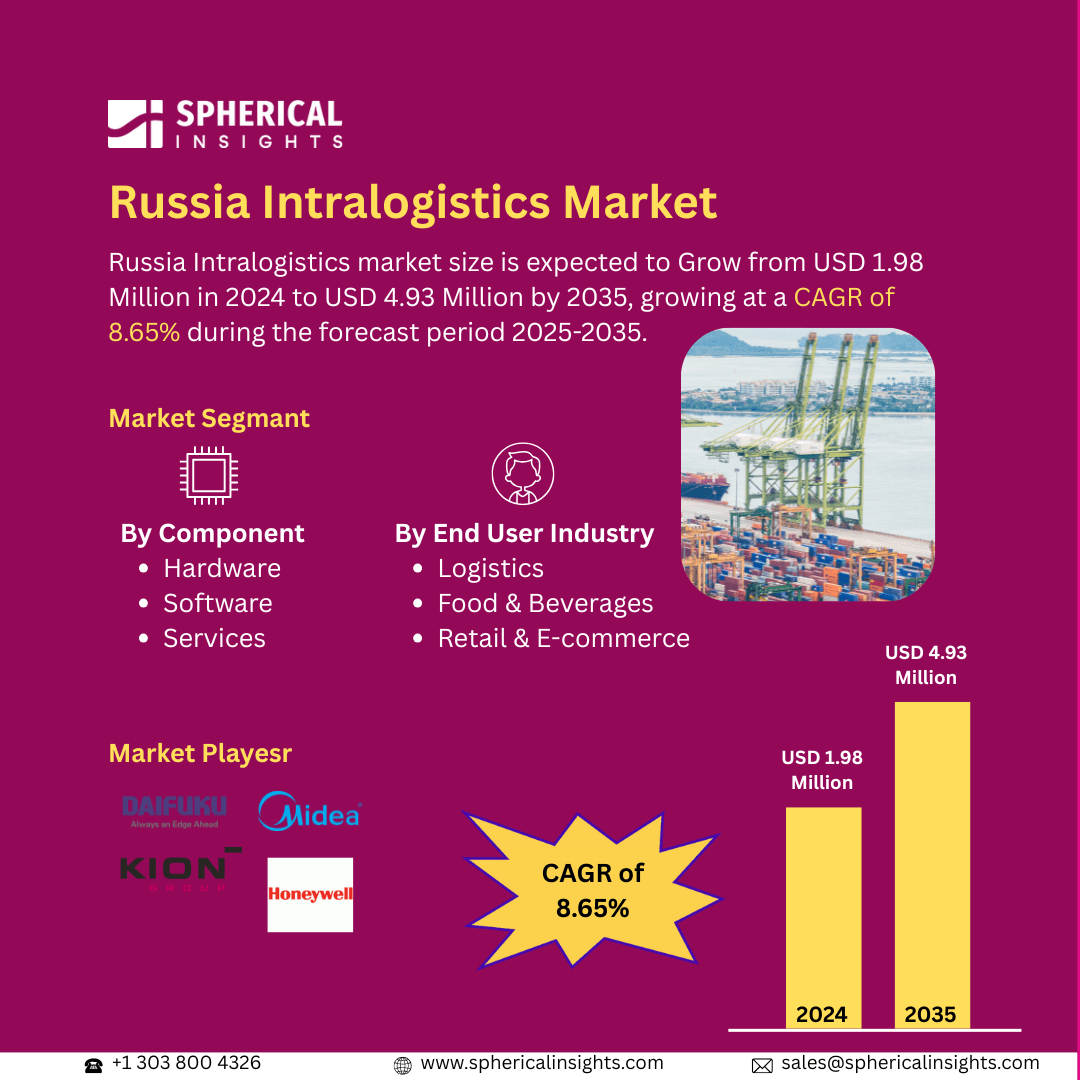Automotive Exhaust Analyzer Market Summary, Size & Emerging Trends
According to Spherical Insights, The Global Automotive Exhaust Analyzer Market Size is Expected to Grow from USD 754 Million in 2024 to USD 1,237 Million by 2035, at a CAGR of 4.6% during the forecast period 2025-2035. The global automotive exhaust analyzer market is driven by increasing stringent emission regulations and growing demand for vehicle emission monitoring and control technologies.
Key Market Insights
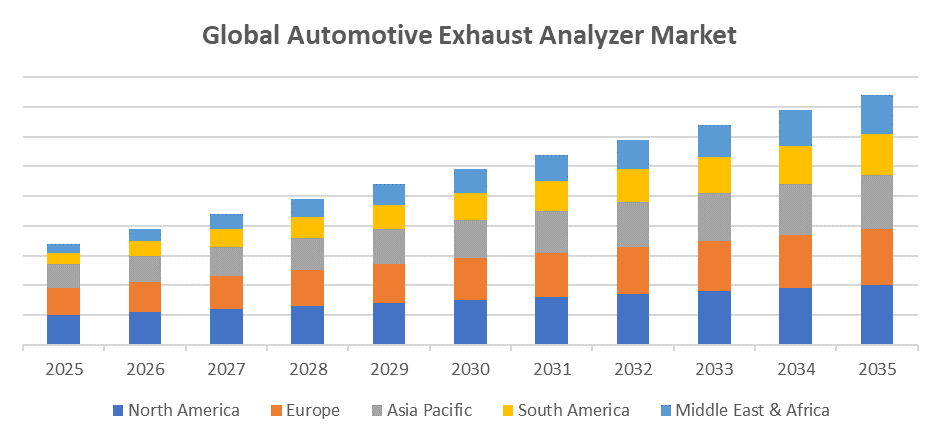
- Asia Pacific is expected to account for the largest share in the automotive exhaust analyzer market during the forecast period.
- In terms of sensors, the non-dispersive infrared segment is projected to lead the automotive exhaust analyzer market throughout the forecast period
- In terms of vehicle type, the passenger car segment captured the largest portion of the automotive exhaust analyzer market
Global Market Forecast and Revenue Outlook
- 2024 Market Size: USD 754 Million
- 2035 Projected Market Size: USD 1,237 Million
- CAGR (2025-2035): 4.6%
- Asia Pacific: Largest market in 2024
- North America: Fastest growing market
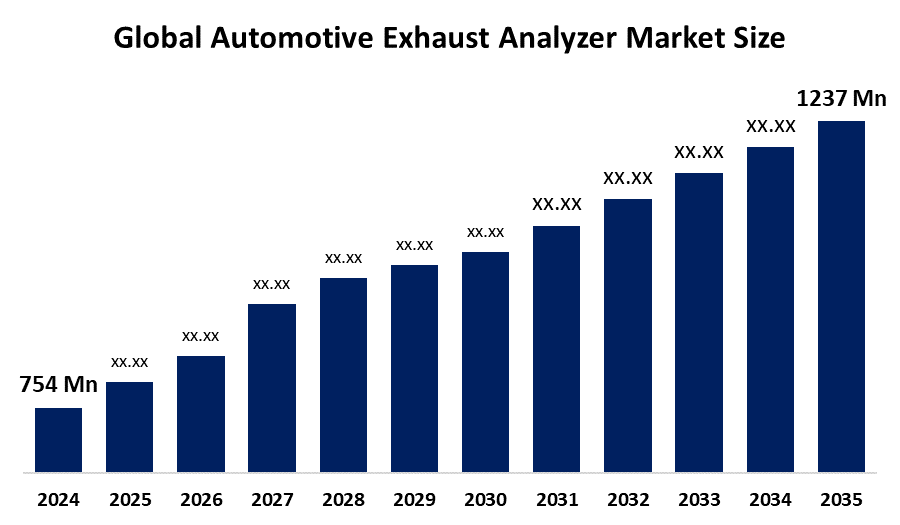
Automotive Exhaust Analyzer Market
The Automotive Exhaust Analyzer Market Size is growing steadily due to rising environmental awareness and strict emission control regulations. Exhaust analyzers are essential tools used to measure harmful gases such as carbon monoxide (CO), carbon dioxide (CO2), nitrogen oxides (NOx), and hydrocarbons from vehicle exhaust systems. They help ensure that vehicles comply with emission standards, supporting cleaner air and public health. Governments are actively promoting emission monitoring through policies like vehicle emission testing programs and mandatory periodic inspections. These initiatives boost the adoption of exhaust analyzers in automotive workshops, inspection centers, and service stations. Additionally, advancements in vehicle technology and increased production of fuel-efficient vehicles have raised the need for precise and reliable emission measurement tools. The market benefits from ongoing innovation, including portable and digital exhaust analyzers, which offer ease of use and accurate results. Overall, the market plays a crucial role in supporting sustainable and eco-friendly automotive practices.
Automotive Exhaust Analyzer Market Trends
- Governments worldwide are enforcing tighter emission standards such as Euro 6, Bharat 6, China 6, and the U.S. EPA’s Tier 3 rules. These policies increase demand for advanced exhaust analyzers that ensure compliance under real-world conditions.
- Manufacturers are adding AI and IoT features to exhaust analyzers, enabling real-time monitoring, predictive maintenance, and cloud-based diagnostics. These smart systems improve testing efficiency and accuracy.
- There is rising demand for compact, portable, and multi-gas analyzers. Innovations such as infrared sensors and laser absorption technology support accurate emissions testing in various environments.
- Scandals involving emission test manipulation have increased scrutiny, driving innovation in high-accuracy, regulation-compliant exhaust analyzers and rebuilding industry trust.
Automotive Exhaust Analyzer Market Dynamics
Driving Factors: Rising vehicle production boosts demand in the automotive exhaust analyzer market.
The growth of the automotive exhaust analyzer market is driven by increasing environmental awareness and the enforcement of stricter global emission regulations. Rising vehicle production and the need for periodic emission testing are fueling demand for reliable exhaust analysis tools. Government initiatives promoting low-emission and fuel-efficient vehicles further support market expansion. Technological advancements, such as portable and smart analyzers integrated with IoT and AI, enhance accuracy and ease of use, attracting service centers and inspection facilities. Additionally, growing public concern over air pollution and health impacts is encouraging regular emissions monitoring, reinforcing the market’s growth trajectory across the automotive industry.
Restrain Factors: Inconsistent enforcement of emission regulations limits growth in the automotive exhaust analyzer market.
High initial costs of advanced analyzers can deter adoption, especially among small and mid-sized workshops. Limited awareness in developing regions about emission testing and environmental compliance also hampers market growth. Additionally, the rising adoption of electric vehicles, which do not emit exhaust gases, may reduce long-term demand for traditional exhaust analyzers. Frequent calibration and maintenance requirements can lead to operational inefficiencies and added costs. Furthermore, inconsistent enforcement of emission regulations in some countries weakens the incentive for regular testing, affecting market penetration and limiting broader implementation of exhaust analysis solutions.
Opportunity: Growing focus on vehicle health monitoring drives the automotive exhaust analyzer market.
The automotive exhaust analyzer market presents significant opportunities driven by the global shift toward cleaner transportation. As governments strengthen emission regulations, demand for advanced and accurate exhaust analyzers will continue to rise. The growth of hybrid vehicles, which still require emission monitoring, adds to market potential. Emerging markets, particularly in Asia, Africa, and Latin America, offer untapped opportunities due to rising vehicle ownership and increasing regulatory awareness. Technological advancements such as cloud-based diagnostics, wireless connectivity, and integration with onboard vehicle systems open new avenues for innovation and service efficiency. Additionally, the growing focus on vehicle health monitoring and preventive maintenance in fleet management creates demand for portable and smart exhaust analyzers, expanding their use across commercial and public transport sectors.
Challenges: Lack of skilled technicians hinders the automotive exhaust analyzer market.
The automotive exhaust analyzer market faces several challenges, including the rising adoption of electric vehicles, which do not require exhaust analysis, potentially shrinking the market. High equipment costs and the need for regular maintenance can deter small service providers. Inconsistent enforcement of emission regulations across regions limits uniform market growth. Additionally, lack of skilled technicians to operate advanced analyzers and limited awareness about emissions testing in developing countries further hinder widespread adoption and affect overall market expansion.
Global Automotive Exhaust Analyzer Market Ecosystem Analysis
The global automotive exhaust analyzer market ecosystem includes key players such as OEMs, aftermarket service providers, regulatory bodies, and technology developers. Growth is driven by strict emission regulations and advances in AI and IoT for real-time monitoring. The market serves both passenger and commercial vehicles, with emerging regions offering new opportunities. Challenges include high costs and a shortage of skilled technicians. Overall, technological innovation and increasing environmental regulations are shaping a dynamic market focused on accurate, efficient emissions testing worldwide.
Global Automotive Exhaust Analyzer Market, By Sensors
The non-dispersive infrared segment is projected to lead the automotive exhaust analyzer market throughout the forecast period, holding approximately 50%. This is because NDIR technology is highly effective at detecting gases like carbon monoxide, carbon dioxide, and hydrocarbons in vehicle emissions. It offers high accuracy, reliability, and cost-efficiency, making it widely preferred by manufacturers and service providers. As a result, NDIR analyzers are expected to make up about half of the market share, underscoring their dominant position in emissions testing.
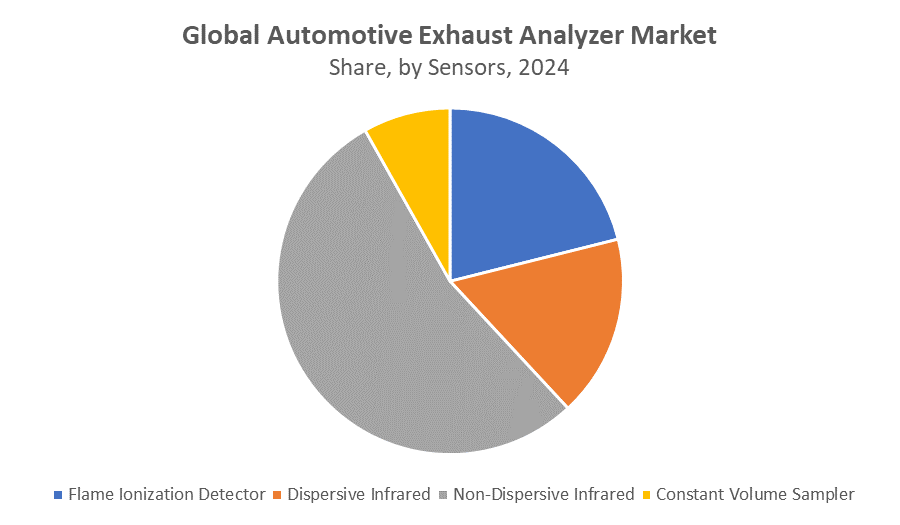
The flame ionization detector segment is anticipated to grow at the fastest CAGR over the forecast period, holding around 25% of the market share. This growth is driven by its high sensitivity and accuracy in detecting hydrocarbons, making it essential for stringent emission monitoring. Its ability to measure low concentrations of pollutants efficiently is increasing its adoption in automotive exhaust analysis, contributing to its rapid market expansion and significant share within the overall market.
Global Automotive Exhaust Analyzer Market, By Vehicle Type
The passenger car segment captured the largest portion of the automotive exhaust analyzer market due to the high volume of passenger vehicles on the road globally. Regular emissions testing for passenger cars is mandatory in many regions to comply with environmental regulations, driving demand for exhaust analyzers. Additionally, the widespread use of passenger vehicles for daily transportation increases the need for monitoring and controlling emissions, making this segment the dominant contributor to the market’s growth.
The LCV segment accounted for a significant revenue share of the global automotive exhaust analyzer market during the forecast period. This is due to the growing use of LCVs in logistics, delivery, and commercial transportation, which are subject to strict emission regulations. The increasing focus on reducing pollution from commercial fleets has boosted demand for exhaust analyzers tailored to LCVs, contributing substantially to the market’s overall revenue growth.
Asia Pacific is expected to account for the largest share of the automotive exhaust analyzer market during the forecast period, holding approximately 40% of the market share, driven by rapid industrialization, increasing vehicle production, and stringent emission regulations in countries like China and India. Rising environmental awareness and government initiatives promoting cleaner transportation also contribute to the region’s dominance, making it a key market for automotive exhaust analyzers.
China is experiencing steady and significant growth in the automotive exhaust analyzer market, accounting for approximately 21.3% of the global market share, fueled by rapid industrialization, increasing vehicle production, and the implementation of strict emission regulations. Additionally, government initiatives focused on reducing air pollution and promoting environmental sustainability are driving the demand for advanced exhaust analyzers across the country.
North America is anticipated to register the highest CAGR in the automotive exhaust analyzer market during the forecast period, contributing around 30% to the overall market share, driven by stringent emission regulations, strong government support for clean air initiatives, and advanced technological adoption in the automotive sector. Additionally, increasing vehicle inspections and maintenance programs further boost demand for reliable exhaust analyzers across the region.
The United States is experiencing steady and significant growth in the automotive exhaust systems segment, accounting for approximately 25% of the market share, driven by strict emission regulations, increasing vehicle production, and ongoing advancements in exhaust system technologies. Additionally, rising consumer demand for cleaner and more efficient vehicles supports the expansion of this segment within the U.S. market.
WORLDWIDE TOP KEY PLAYERS IN THE AUTOMOTIVE EXHAUST ANALYZER MARKET INCLUDE
- Bosch
- Horiba Ltd.
- AVL List GmbH
- Siemens AG
- MAHA Engineering
- Testo SE & Co. KGaA
- Fuji Electric Co., Ltd.
- Emerson Electric Co.
- Dynament Ltd.
- Testline Instruments
- Others
Product Launches in Automotive Exhaust Analyzer
- In March 2024, Intangles launched an AI-driven Diesel Particulate Filter (DPF) solution designed to enhance fuel efficiency and performance in commercial vehicles, meeting the rising demand for sustainable transportation solutions.
- In March 2022, Sensors unveiled the SEMTECH NOx measurement solution, a portable emissions measurement system (PEMS) that meets EPA and Real Driving Emissions (RDE) regulatory requirements, offering measurement accuracy for nitric oxide (NO) and nitrogen dioxide (NO2).
Market Segment
This study forecasts revenue at global, regional, and country levels from 2020 to 2035. Spherical Insights has segmented the automotive exhaust analyzer market based on the below-mentioned segments:
Global Automotive Exhaust Analyzer Market, By Sensors
- Flame Ionization Detector
- Dispersive Infrared
- Non-Dispersive Infrared
- Constant Volume Sampler
Global Automotive Exhaust Analyzer Market, By Vehicle Type
Global Automotive Exhaust Analyzer Market, By Regional Analysis
- Asia Pacific
- Europe
- Germany
- UK
- France
- Italy
- Spain
- Russia
- Rest of Europe
- Asia Pacific
- China
- Japan
- India
- South Korea
- Australia
- Rest of Asia Pacific
- South America
- Brazil
- Argentina
- Rest of South America
- Middle East & Africa
- UAE
- Saudi Arabia
- Qatar
- South Africa
- Rest of the Middle East & Africa
FAQs
Q: Which vehicle type segment captured the largest portion of the automotive exhaust analyzer market?
A: The passenger car segment captured the largest market share due to the high volume of passenger vehicles globally.
Q: What are the key drivers of growth in the automotive exhaust analyzer market?
A: Increasing stringent emission regulations, rising environmental awareness, growing vehicle production, and advances in smart technologies such as AI and IoT are the main growth drivers.
Q: What are the main challenges limiting the adoption of automotive exhaust analyzers?
A: High initial costs, inconsistent enforcement of emission regulations, lack of skilled technicians, and rising adoption of electric vehicles pose key challenges.
Q: Which companies are the top players in the Global Automotive Exhaust Analyzer Market?
A: Leading companies include Bosch, Horiba Ltd., AVL List GmbH, Siemens AG, MAHA Engineering, Testo SE & Co. KGaA, Fuji Electric Co., Ltd., Emerson Electric Co., Dynament Ltd., and Testline Instruments.
Q: What are some recent product innovations in the automotive exhaust analyzer market?
A: In March 2024, Intangles launched an AI-driven Diesel Particulate Filter (DPF) solution for commercial vehicles. In March 2022, Sensors introduced the SEMTECH NOx portable emissions measurement system meeting EPA and RDE regulations.
Q: How do government regulations impact the automotive exhaust analyzer market?
A: Stringent emission standards such as Euro 6, Bharat 6, China 6, and U.S. EPA Tier 3 rules significantly drive demand for advanced exhaust analyzers ensuring compliance.
Q: What are the emerging trends in the automotive exhaust analyzer market?
A: Trends include integration of AI and IoT for real-time monitoring, demand for portable multi-gas analyzers, and innovations in sensor technologies like infrared and laser absorption.
Q: What is the outlook for the automotive exhaust analyzer market in Asia Pacific, especially China?
A: Asia Pacific is the largest market due to rapid industrialization, increasing vehicle production, and strict emission regulations. China alone accounts for about 21.3% of the global market share driven by government initiatives on air pollution control.
Q: How is the adoption of electric vehicles impacting the automotive exhaust analyzer market?
A: The rising adoption of electric vehicles, which do not emit exhaust gases, may reduce the long-term demand for traditional exhaust analyzers.
